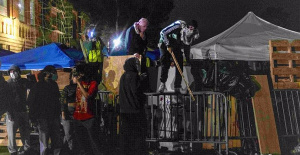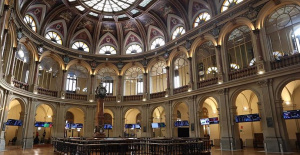VALENCIA, July 10 (EUROPA PRESS) -
A study led by the Universitat Politècnica de València (UPV), in which research staff from the Universitat Politècnica de Catalunya - Barcelona Tech (UPC) and the Institute of Photonic Sciences (ICFO), linked to this university, have also participated, has discovered photonic snakes, a new instrument to reveal the secrets of light.
The work, published in the journal 'Nature Photonics', paves the way towards an "exciting future of advanced optical devices"
From the UPV they point out that light, with its innumerable colors, is one of the wonders of nature. To really understand what we see it is essential to know the color of light with which we perceive our world. We achieved this through some optical rules called frequency combs (frequency combs in English), whose first achievement earned the Nobel Prize in Physics in 2005.
With optical rulers, not only colors are measured, but also times, distances, and other essential magnitudes; hence its importance in scientific and technological applications is enormous. They are the tools that allow you to enter the kingdom of light and reveal its deepest secrets.
And this is precisely what a recent study led by the Polytechnic of Valencia allows. In their work, they have discovered the 'Photonic snake states', a new instrument to unlock the secrets of light.
This study has captured the attention of the international scientific community and opens new perspectives on the formation of frequency combs: it predicts the existence of two-dimensional optical rulers, more complex than the one-dimensional ones handled up to now, and that provide unprecedented versatility in a wide range of applications. range of applications.
The uses of frequency combs are very varied, and they stand out above all in the field of communications. As the authors of the study explain, these combs make it possible to transmit large amounts of information through optical fibers very efficiently since, having well-defined frequencies, multiple light signals can be sent at the same time and easily separated when received. .
Another area where frequency combs have shown great utility is in spectroscopy. By being able to obtain optical spectra with unprecedented precision and resolution, the identification of different substances is facilitated. This has direct application in fields such as chemistry, biology and medicine, where the precise detection of molecules and the characterization of materials is essential.
In the case of metrology, the science of measurement, these structures are used as a reference to define standards, thanks to their ability to generate stable and known frequencies. This allows very precise measurements in fundamental quantities, such as time or length, relevant to most scientific fields.
Finally, frequency combs have also found promising applications in quantum computing, where light particles (or photons) play a key role. Specifically, frequency combs can be used to generate individual photons with specific properties, which is crucial for the development of these technologies.
A fundamental problem that must be analyzed in order to be successful in these proposals is that of the instabilities that appear when trying to build these optical rulers and that prevent versatile forms of light from being generated. As Professor Pedro Fernández de Córdoba, a researcher at the IUMPA of the UPV and co-author of this work, points out, "it should be noted that our team has obtained, from a theoretical point of view, the conditions for the light structure to be stable, finding zig-zag configurations that we have called Photonic Serpents. The stability of these light states is a crucial aspect for future applications."
Likewise, in this article it has been shown that it is possible to create a two-dimensional arrangement of optical rulers synchronized with each other and individually accessible. This discovery provides a comprehensive collection of rules generated on a single device and controlled by a single laser light source.
In fact, as Professor Carles Milián, responsible for this research, states: "the potential impact of this advance is extraordinary, since it could allow the development of reconfigurable and broadband monolithic multicomb devices. These devices would supply different frequency combs on demand and in real time, significantly expanding existing applications."
Finally, this study has been based on rigorous and very complete theoretical models, which have taken into account all the known effects that could appear in future experiments on the formation of two-dimensional frequency combs, and which have been simulated using powerful theoretical tools and numeric.
In fact, as Professor J. Alberto Conejero, director of the Department of Applied Mathematics at the UPV and co-author of this work, points out, "in this research a very precise model has been built that includes all the phenomena that can influence the formation of these structures. It will work as a guide for future experiments, with the consequent economic impact by knowing in advance the experimental parameters with which stable light serpents can be generated."
This discovery marks a milestone in the physics of these structures and paves the way to an "exciting future of advanced optical devices." Salim B. Ivars (Polytechnic University of Catalonia), and Yaroslav V. Kartashov and Lluís Torner (ICFO) have also participated in the work. According to the latter, "this important discovery is remarkable for being unexpected and surprising, and it has been possible thanks to the intuition and leadership of Professor Milián."
The UPV, UPC and ICFO team assures that this finding will further stimulate research in the field and will lead to new applications and revolutionary technologies. "Thanks to these advances, we are one step closer to unraveling the mysteries of light and harnessing its full potential for the benefit of our society," they conclude.

 Exploring Cardano: Inner Workings and Advantages of this Cryptocurrency
Exploring Cardano: Inner Workings and Advantages of this Cryptocurrency Seville.- Economy.- Innova.- STSA inaugurates its new painting and sealing hangar in San Pablo, for 18 million
Seville.- Economy.- Innova.- STSA inaugurates its new painting and sealing hangar in San Pablo, for 18 million Innova.- More than 300 volunteers join the Andalucía Compromiso Digital network in one month to facilitate access to ICT
Innova.- More than 300 volunteers join the Andalucía Compromiso Digital network in one month to facilitate access to ICT Innova.-AMP.- Ayesa acquires 51% of Sadiel, which will create new technological engineering products and expand markets
Innova.-AMP.- Ayesa acquires 51% of Sadiel, which will create new technological engineering products and expand markets A ball of light crosses Spain and Portugal
A ball of light crosses Spain and Portugal Prime Minister Fico is stabilized within gravity
Prime Minister Fico is stabilized within gravity Israel's Minister for the Diaspora considers Sánchez "responsible" for there being "more victims" in Gaza
Israel's Minister for the Diaspora considers Sánchez "responsible" for there being "more victims" in Gaza Barça strikes down Real to lift the Queen's Cup
Barça strikes down Real to lift the Queen's Cup How Blockchain in being used to shape the future
How Blockchain in being used to shape the future Not just BTC and ETH: Here Are Some More Interesting Coins Worth Focusing on
Not just BTC and ETH: Here Are Some More Interesting Coins Worth Focusing on The UA participates in the proposed Ramses mission to study the close passage of an asteroid to Earth
The UA participates in the proposed Ramses mission to study the close passage of an asteroid to Earth They develop a tool to end discrimination biases in AI
They develop a tool to end discrimination biases in AI A research group from the UA works on the development of healthy foods through AI
A research group from the UA works on the development of healthy foods through AI The Valencian researcher José Rafael Penadés, named 'fellow' of the British Royal Society
The Valencian researcher José Rafael Penadés, named 'fellow' of the British Royal Society A million people demonstrate in France against Macron's pension reform
A million people demonstrate in France against Macron's pension reform Russia launches several missiles against "critical infrastructure" in the city of Zaporizhia
Russia launches several missiles against "critical infrastructure" in the city of Zaporizhia A "procession" remembers the dead of the Calabria shipwreck as bodies continue to wash up on the shore
A "procession" remembers the dead of the Calabria shipwreck as bodies continue to wash up on the shore Prison sentences handed down for three prominent Hong Kong pro-democracy activists
Prison sentences handed down for three prominent Hong Kong pro-democracy activists ETH continues to leave trading platforms, Ethereum balance on exchanges lowest in 3 years
ETH continues to leave trading platforms, Ethereum balance on exchanges lowest in 3 years Investors invest $450 million in Consensys, Ethereum incubator now valued at $7 billion
Investors invest $450 million in Consensys, Ethereum incubator now valued at $7 billion Alchemy Integrates Ethereum L2 Product Starknet to Enhance Web3 Scalability at a Price 100x Lower Than L1 Fees
Alchemy Integrates Ethereum L2 Product Starknet to Enhance Web3 Scalability at a Price 100x Lower Than L1 Fees Mining Report: Bitcoin's Electricity Consumption Declines by 25% in Q1 2022
Mining Report: Bitcoin's Electricity Consumption Declines by 25% in Q1 2022 Oil-to-Bitcoin Mining Firm Crusoe Energy Systems Raised $505 Million
Oil-to-Bitcoin Mining Firm Crusoe Energy Systems Raised $505 Million Microbt reveals the latest Bitcoin mining rigs -- Machines produce up to 126 TH/s with custom 5nm chip design
Microbt reveals the latest Bitcoin mining rigs -- Machines produce up to 126 TH/s with custom 5nm chip design Bitcoin's Mining Difficulty Hits a Lifetime High, With More Than 90% of BTC Supply Issued
Bitcoin's Mining Difficulty Hits a Lifetime High, With More Than 90% of BTC Supply Issued The Biggest Movers are Near, EOS, and RUNE during Friday's Selloff
The Biggest Movers are Near, EOS, and RUNE during Friday's Selloff Global Markets Spooked by a Hawkish Fed and Covid, Stocks and Crypto Gain After Musk Buys Twitter
Global Markets Spooked by a Hawkish Fed and Covid, Stocks and Crypto Gain After Musk Buys Twitter Bitso to offset carbon emissions from the Trading Platform's ERC20, ETH, and BTC Transactions
Bitso to offset carbon emissions from the Trading Platform's ERC20, ETH, and BTC Transactions Draftkings Announces 2022 College Hoops NFT Selection for March Madness
Draftkings Announces 2022 College Hoops NFT Selection for March Madness























